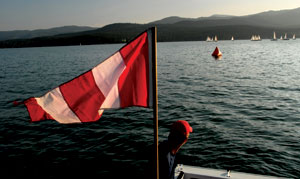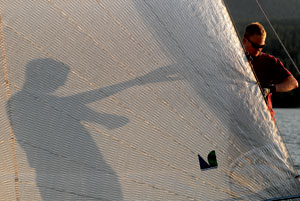SOMERS – Waiting to begin at the North Flathead Yacht Club, racers are wandering between boats, discussing the last race and how many people will be competing tonight.
And, as always, they’re talking about the wind.
“It depends on the wind,” says John Frommer. “A lot of times we’ll just go out and bob around for a couple of hours.”
This is Frommer’s second season at Somers and third sailboat racing. He’s helping the crew on Ted Rebmann’s J80 named “Sheva,” which Rebmann calls the “goddess of destruction.” The J80 was built in France, and is about 27 feet long.
 |
|
Racers fly their spinnakers while running before the wind after the first turn during the North Flathead Yacht Club’s Tuesday night races. |
Rebmann has been racing for 40 years throughout the West Coast. Once in Montana, the urge to sail was too strong to ignore.
“I tried shooting trap,” says Rebmann, “but it just doesn’t work.”
This is the North Flathead Yacht Club: people of all ages and skill levels honing their seamanship during weekly races. Tuesday night races are a little less competitive than Friday’s, so not everyone can use a spinnaker. There are three fleets: A, B and C. The A Fleet comprises the biggest, fastest boats, while the midsized are in B and the smallest are in C. The race steward sets up three buoys – an orange triangle at the start, a round orange buoy halfway and another triangular buoy out in the lake.
The wind begins to pick up and the sailors get to work, unwrapping sails, hoisting the main, and motoring out of their slips and into the bay.
 |
|
Race Steward Scott Galbraith watches the wind rising on Flathead Lake. The process of starting the race is laborious not knowing how soon the wind will be strong enough to race with or what direction it will blow. In the background, sailing yachts cruise patiently near the start. |
“Oh, there’s a nice breeze,” says Sherry Abel, who is a crewmember on her husband Tom’s Santa Cruz 33. Sherry’s daughter, Christa, and 6-year-old granddaughter, Mallory, are onboard today.
“There’s 30 boats out there; I counted all of them,” says Mallory as she swings on the ladder in the cabin. These 30 boats are maneuvering back and forth, avoiding each other and trying to stay as close to the starting buoy as possible.
“The wind’s doing funny things,” says Tom, nosing the boat along the edge of the wind. “It’s coming from the south. That’s not good.”
They race from the west to the east in their A-Fleet boat, away from the sunset and back. But, as Tom points out, the wind always starts blowing from the west once the sun sets.
When the race is about to start the steward raises the red prep flag and a horn sounds and boaters start their timers. Then the steward raises a fleet flag, a four-minute warning to the C Fleet. Once the red flag goes down and a horn blows, they have one minute. After that flag goes down and another horn sounds, the C Fleet takes off and the sequence starts over again for the next two fleets.
 |
|
A crewmember watches the time before the start of a Tuesday nigh race. |
The A Fleet races the farthest; triangle to triangle and back again. The B-Fleet boats race triangle-to-triangle and halfway back, while the C Fleet goes from the start point to halfway and back. They all finish at about the same time.
“Get ready to tack,” says Tom. Mallory ducks inside the cabin, the crew pulls ropes and cranks winches as the jib and mast pull to the other side and the boats start along a new side of the triangle routes to the buoy.
“Get ready to tack,” Tom says again, and again, and again. Sherry and Christa loosen and tighten the sails, and the reporter up on the bow makes sure the jib doesn’t tangle as it flaps from one edge of the boat to the other. In between tacks the boat glides, skimming across the water and trying to gain an edge on the boats ahead.
By the end, it’s about 11 p.m. The last traces of the sunset are petering out as lights from the shore begin flicking on. The motorboats that came out to watch start heading home, and the sailors start taking down sails and motoring back to the harbor.
“Then,” says Tom, “we all have a beer on the dock.”
 |
|
|